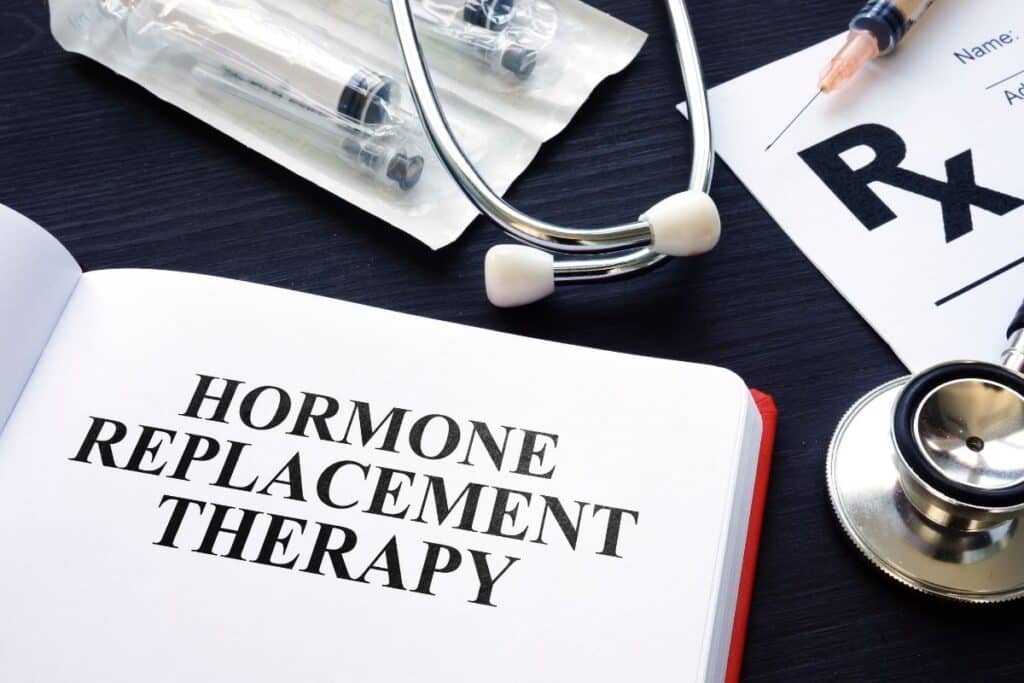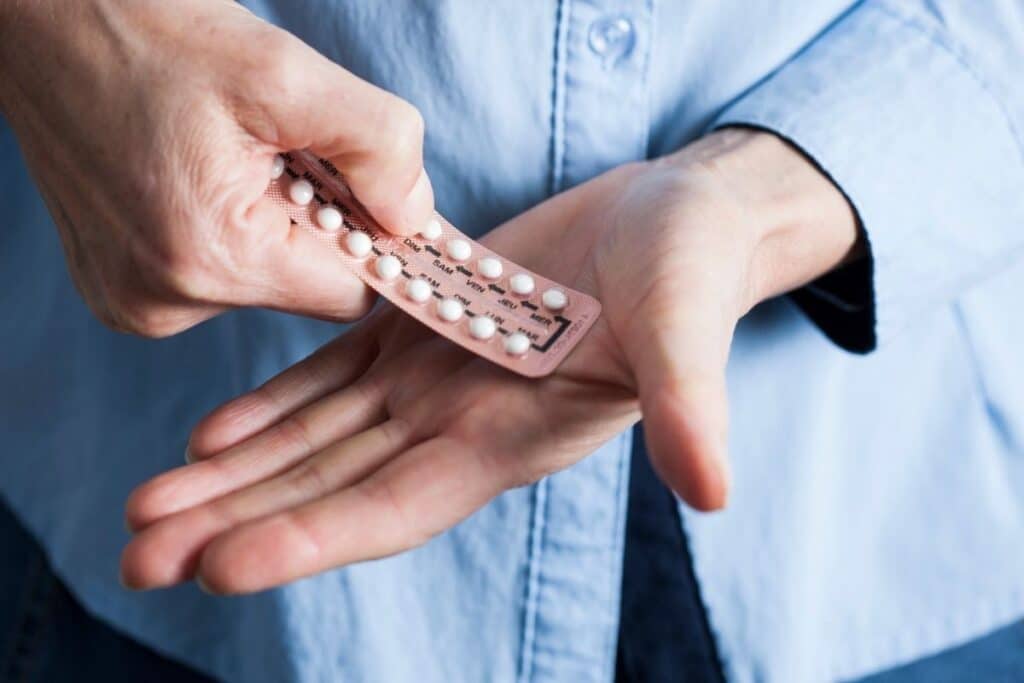Hormone therapy is used to treat a myriad of disorders, particularly ones that are associated with aging.
Hormones are a natural compound made and released by endocrine glands all over your body.
They serve a myriad of biological functions, though they predominantly act as messengers between one part of your body and another.

Hormone replacement therapy (HRT) is the replacement of hormones that your body isn’t naturally producing through medication, like pills, gels, patches, and creams.
It is best known as a common treatment for uncomfortable menopausal symptoms, such as hot flashes or vaginal discomfort.
Hormone therapy is now also available for men – to help with unnaturally low testosterone levels.
Read on to discover all of the basics of HRT, from why it might be necessary, how it is administered, and what the benefits and risks are.
Hormones Begin To Decline…
Age, certain diseases, or disorders that you have inherited from your parents, can have an effect on the levels of hormones in your body and blood stream.
For women, aging related hormone changes result in menopause.
Changes in hormone levels begin around age 50, as women’s ovaries start to decrease in the amounts of estrogen and progesterone that they produce. Then, symptoms of menopause quickly follow.
For men, diseases like type two diabetes, chronic liver or kidney disease, COPD, lung disease or problems with the pituitary gland can cause an unusual drop in testosterone.
However, naturally, testosterone levels will slowly decrease after around the age of 30 (and will continue to drop in production by about 1% every year).
Types Of Hormone Replacement Therapy
There are two basic types of hormone therapy, which focus on replacing hormones in your body that you are not naturally producing, because you are aging and/or going through menopause.
For women, the two kinds of hormone replacement therapy are:
- Systemic hormone therapy comes in a pill, a skin patch, a ring, a gel, a cream, or in a spray form. Usually, it contains a higher concentration (and therefore a higher dose) of estrogen, which is absorbed throughout the body. Typically, this type is used to treat most of the common symptoms of menopause.
- Low dose vaginal products, which come in cream, tablet, gel, or spray form, which therefore minimizes the amount of estrogen that is absorbed, and does not have an effect around the body. Due to this, low-dose vaginal HRT products are only used to treat the vaginal and urinary symptoms of menopause.
If you have been prescribed estrogen replacement therapy, then your doctor will also likely prescribe you the hormone progesterone (or progestin, a progesterone-like medication).
They will do this to prevent some of the negative side effects of estrogen replacement therapy.
Without balancing it against progesterone, it can stimulate the lining of the uterus to grow, and can increase the risk of endometrial cancer.
If you have had your uterus removed in a hysterectomy procedure, then you might not need to take progesterone.
For men, hormone replacement therapy can take three different forms.
If your doctor has suggested that you take a course of hormone replacement therapy, there are a few different options that are available to you:
- Intramuscular injections of testosterone, where your doctor will inject extra testosterone into the muscles on your buttocks every two to three weeks.
- Testosterone patches, which you will apply yourself every day. You can put this on your back, abdomen, arms, or buttocks – just be careful that you rotate where you place these.
- A topical testosterone gel, which you will apply each day on two areas, such as your shoulders, arms or abdomen.
Hormone Replacement Therapy For Women
When used in women, HRT is used primarily for one purpose – to relieve symptoms of menopause.
However, there are a wide range of individual symptoms of menopause that hormone replacement therapy can help to ease or totally eliminate.
The specific things that hormone replacement therapy can help with include (but are not limited to):
- Moderate to severe hot flashes are effectively treated using systemic estrogen therapy.
- Other symptoms of menopause, as the hormone estrogen can ease vaginal symptoms of menopause, like dryness, itching, burning, and general discomfort.
- Bone loss or fractures can be prevented and treated with systemic estrogen. HRT helps to protect against bone thinning (which is a disease called osteoporosis). Though the most commonly prescribed treatment is bisphosphonates to treat cases of thinning bones, patients will be prescribed systemic estrogen if they can’t tolerate bisphosphonates, or aren’t responding well to them.
- Early menopause or estrogen deficiency. HRT can be beneficial if you have had your ovaries surgically removed by age 45, stopped having periods before age 45 (which is known as early/premature menopause), or lost normal functioning of your ovaries before age 40 (which is known as primary ovarian insufficiency). This is because your body has been exposed to lower levels of estrogen (or less estrogen overall) when compared to those who experience typical menopause and hormone levels. Estrogen therapy can decrease the risk of developing certain health conditions, like osteoporosis, heart disease, dementia, stroke and changes in mood/personality.
Hormone Replacement Therapy For Men
Unlike HRT for women, this treatment isn’t usually given to men who are experiencing signs of aging.
Rather, it is reserved for those that suffer from unnaturally low levels of testosterone, compared to the rest of their age group.

This is because there is little scientific evidence that supports testosterone replacement therapy, helping them combat signs, simply caused by aging.
Studies have come back with unclear results. However, it could be something researched and offered further in the future.
Hormone replacement therapy for men benefits men with a naturally low levels of testosterone, such as those who suffer from hypogonadism, which is a dysfunction of the testicles (an endocrine/hormone producing gland), preventing them from producing the right amount of testosterone.
Hormone Replacement Therapy Side Effects
For women, hormone replacement therapy includes risks like:
- Increased risk of breast cancer when taking combined HRT, or using it long term.
- Higher risk of developing endometrial cancer.
- Increased risk of blood clots when you take hormone replacement tablets.
- Increased risk of heart disease and strokes, though this is small.
- Gallbladder and gallstone problems.
- Increased risk of developing dementia if hormone therapy is started after the midlife point. However, it is also associated with a reduced risk of Alzheimer’s or dementia if started before midlife.
- Monthly bleeding.
- Irregular spotting.
- Enlarged or tender breasts.
- Mood swings.
- Fluid retention, headaches and migraines.
- Skin discoloration with black or brown spots.
- Increased breast density.
- Skin irritation under estrogen patches.
For men, hormone replacement therapy includes risks like:
- Fluid retention.
- Increased acne.
- Increased frequency of urination.
- Enlargement of breasts.
- Decrease in testicle size.
- Worsening of any existing sleep apnea.
- Increased blood cholesterol levels.
- Decreased sperm count.
- Potential infertility.
And an increase in the number of red blood cells (which in turn may cause muscle pain, blurred vision, increase in blood pressure, chest pain, and/or clots in your blood vessels).
That being said – with hormone replacement therapy, the benefits usually outweigh the risks.
However, your medical decision are your own, and you should always fully inform yourself about the benefits and risks of a medical treatment before you begin, so you can measure up whether it is the right decision for you.
Final Thoughts
Hormone replacement therapy can be a great option for you if you are experiencing symptoms of reduced hormone levels, helping to prevent or reverse negative changes associated with menopause, disease, hysterectomy, or hypogonadism.
However, the decision to take hormone therapy is totally personalized, and is not for everyone.
If you are considering embarking on a course of HRT, discuss all of the potential benefits and risks with a healthcare professional.
You should consider your goals for the therapy, your age, family history, your personal medical history, and severity of symptoms.
It is not a treatment for everyone, and there are other treatments that can be taken instead of HRT.

